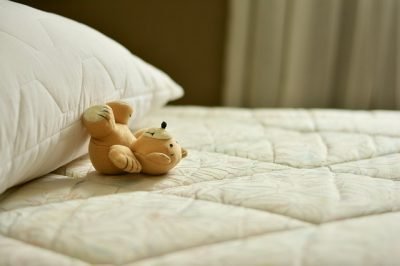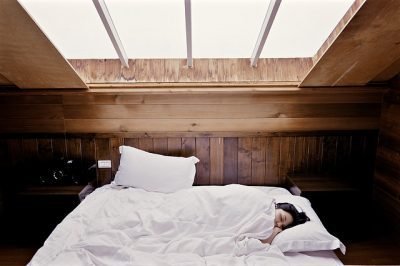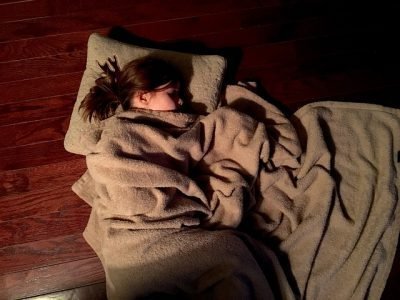 As beneficial as sleeping on our backs is, thanks to the natural alignment of the body it helps maintain and the enormous help it is when we’re down with acid reflux, the stats show that the most popular sleeping position by far for the majority is on our sides. Some 15% individuals prefer sleeping on their sides, log-style, while a whopping 41% favor the fetal position, curling up as they prepare for a trip to snooze-town. So, what does this mean for side-sleepers?
As beneficial as sleeping on our backs is, thanks to the natural alignment of the body it helps maintain and the enormous help it is when we’re down with acid reflux, the stats show that the most popular sleeping position by far for the majority is on our sides. Some 15% individuals prefer sleeping on their sides, log-style, while a whopping 41% favor the fetal position, curling up as they prepare for a trip to snooze-town. So, what does this mean for side-sleepers?
It’s logical to assume that the sleeping position we favor is the one that makes us feel the most comfortable, letting us wind down from a long day and slip into sleep. If you suffer from sleep apnea (a condition characterized by disrupted breathing during sleep, causing you to wake up multiple times and leading to insufficient oxygen supply to the brain and body) or snoring, side-sleeping is a simple way of mitigating these conditions, since the position helps keep your airways open and doesn’t obstruct your breathing through the night. Both fetal and log-style positions can help maintain spinal alignment, so you don’t wake up with neck cramps or an aching back from holding an awkward sleeping position all night. The fetal position is also considered the best sleeping position for pregnant women, since it encourages healthy blood circulation for both the mother and baby, and keeps the uterus from pushing against your liver.
 However, sleeping on your side can lead to some problems, if you’re not careful about it. If your knees touch as you sleep on your side, you risk your upper leg pulling your spine out of alignment, straining your lower back and hips. A too-tight fetal position, with your knees drawn up to your chest and chin tucked in, can constrict your respiratory system and restrict breathing, and put pressure on your back and joints, leaving you waking up to a stiff neck or sore back. Side-sleeping could also be painful for anyone suffering from conditions like sciatica, arthritis or scoliosis, making it difficult for you to maintain the position you’re most used to or comfortable sleeping in.
However, sleeping on your side can lead to some problems, if you’re not careful about it. If your knees touch as you sleep on your side, you risk your upper leg pulling your spine out of alignment, straining your lower back and hips. A too-tight fetal position, with your knees drawn up to your chest and chin tucked in, can constrict your respiratory system and restrict breathing, and put pressure on your back and joints, leaving you waking up to a stiff neck or sore back. Side-sleeping could also be painful for anyone suffering from conditions like sciatica, arthritis or scoliosis, making it difficult for you to maintain the position you’re most used to or comfortable sleeping in.
Fret not though – this is where knee pillows come in. This tiny adjustment to how you sleep can alleviate many, if not all, of the potential problems side-sleepers are faced with.
Why opt for knee pillows?
We typically associate pillows with use for our heads, but knee pillows are an inexpensive and extremely effective addition to our night-time routines that can make the lives of side-sleepers all the better. These keep your knees separated just so, supporting your upper leg so it doesn’t pull on your spine, thus keeping your neck, spine and hips in neutral alignment as you sleep through the night. The neutral position also keeps pressure off sprains and inflamed areas of your body, mitigating pains caused by slipped disks, pinched nerves, arthritis and so on and letting you nod off in your preferred sleeping position without having to forsake rest for a night of fidgeting and pain.
What exactly are knee pillows?
Depending on the brand, knee pillows can come in different styles and shapes, but typically, the most commonplace and effective ones are either hourglass shaped pillows to situate between your thighs or lower legs, or a strap-on pillow to tuck between your lower legs. Both options are much more practical than full-sized bolster or body pillows that can take up space on your bed, or become too stifling and inconvenient when you’re trying to shift around without tangling yourself up in the covers, especially if you experience back pain, osteoarthritis, sciatica or other conditions that could make the movement difficult and painful.
Hourglass knee pillows feature contoured sides that let you tuck the pillow anywhere between your legs, be it your knees, calves or thighs, the curved sides making it much less likely that it will slide out as you sleep. Usable both when you’re sleeping log-style or in a fetal position, the right pillow – which may differ from person to person, depending on height, body type, etc. – will help keep your body properly aligned and you comfortable enough to drift off.
Strap-on pillows differ by not only being longer, but also more restricted in how you can use them (as well as more expensive). The strap goes around one of your lower legs to hold the pillow in place, from your knees to your ankles, or midway up your calf if you prefer to sleep in a fetal position.
When it comes down to picking the right knee pillow for you, it really is mostly about preference – there is no concrete basis for arguments that one type of knee pillow is superior over the other. What can make a difference, though, are the features of these pillows.
What features should you look for in knee pillows?
 If you’re going for an elongated, strap-on type knee pillow, remember to account for the fact that the length of the pillow has to be suitable for the length of your legs. Contoured pillows, on the other hand, are often universally usable, with more of a one size fits all design.
If you’re going for an elongated, strap-on type knee pillow, remember to account for the fact that the length of the pillow has to be suitable for the length of your legs. Contoured pillows, on the other hand, are often universally usable, with more of a one size fits all design.
When it comes to the stuffing of the pillow, it again comes down to a matter of choice. Down is a classic option, particularly for those who like the adjustability of rearranging the pillow to their utmost comfort, but memory foam is also particularly popular, because it can mold to the natural curves of your legs without giving way, and without losing shape after a whole night of being squeezed and compressed while you’re sleeping. This means longer wear as well as better support, crucial for alleviating symptoms of conditions like slipped disks and sciatica.
It’s important to pick knee pillows with removable covers, too – it’s plain unhygienic to use a pillow that sits there accumulating dust and dirt without a simple option for cleaning. Materials can range from synthetic fleece to cotton to breathable polyester-nylon blends, but really depends, again, on your preferences. If you are going for a memory foam option, though, ensure that it is hypoallergenic and less prone to accumulate disease-causing microbes.